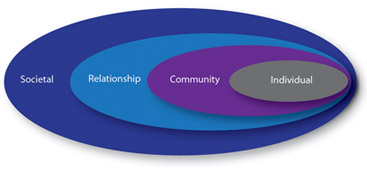Understanding Intimate Partner Violence Prevention as Social Change Work
| “Primary prevention is changing the social norms that allow and condone violence. Preventing violence means changing our society and its institutions—targeting attitudes, beliefs, behaviors, environments and policies to eliminate those that contribute to violence and to promote those that stop the violence. Primary prevention of domestic and sexual violence is defined as preventing violence before it occurs. This is social change work.” (MCADSV, 2012) |
In order to end intimate partner violence, the problem must be addressed and confronted at the societal, community, relationship, and individual levels. Intimate partner violence prevention encompasses proactive efforts to stop violence and abuse from happening in the first place by interrupting the cultural rules, norms, and constructs that support it.
Successful prevention efforts reflect a social change model that promotes a thriving culture where all relationships are built on respect, equality, and peace.
Intimate partner violence (IPV), also referred to as domestic violence, is a pattern of abusive behaviors – including physical, sexual, and psychological attacks as well as economic coercion – that adults and adolescents use against an intimate or dating partner. It is characterized by one partner’s need to control the other by use of a range of tactics.
There are a variety of factors at all levels of the social environment that allow intimate partner violence to exist. Those involved in IPV prevention can learn from a variety of frameworks used more broadly.
Common frameworks for understanding prevention theory include:
 The Social-Ecological Model demonstrates how people may be at risk for experiencing or perpetrating violence and considers the complex interplay between individual, relationship, community, and societal factors. Comprehensive prevention strategies that address multiple levels of the model have the greatest potential for impacting change (CDC, NCIPC).
The Social-Ecological Model demonstrates how people may be at risk for experiencing or perpetrating violence and considers the complex interplay between individual, relationship, community, and societal factors. Comprehensive prevention strategies that address multiple levels of the model have the greatest potential for impacting change (CDC, NCIPC).
While some have shifted away from categorizing prevention strategies in favor of valuing all efforts without regard to the pre-existence of violence, violence prevention is commonly classified in three ways:
-
Primary Prevention: Activities that take place before violence has occurred to prevent initial perpetration or victimization.
-
Secondary Prevention: Immediate responses after violence has occurred to deal with short-term consequences and prevent future perpetration or victimization.
-
Tertiary Prevention: Long-term responses after violence has occurred to deal with the lasting consequences of violence and offender treatment interventions.
A comprehensive response to intimate partner violence involves all three types of prevention (PreventConnect Wiki).
The National IPV Prevention Council is committed to enhancing the capacity of state/territory domestic violence coalitions and community-based domestic violence programs to advance a unified and comprehensive prevention agenda and broaden support for its full implementation at the national, state/territory and local levels. Learn more about the Intimate Partner Violence Prevention Council here.




